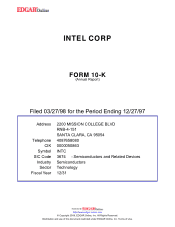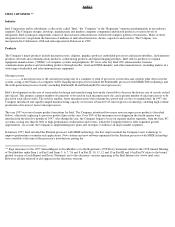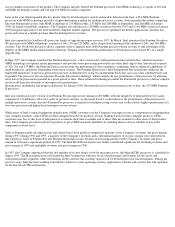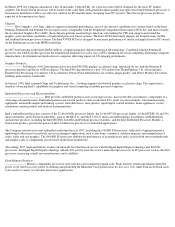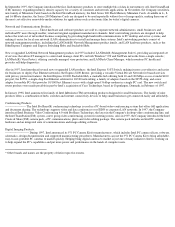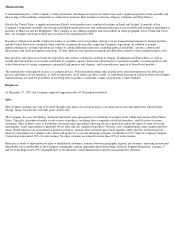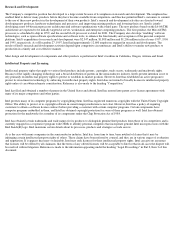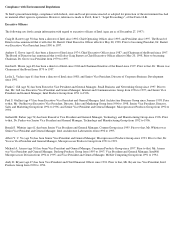Intel 1997 Annual Report Download - page 9
Download and view the complete annual report
Please find page 9 of the 1997 Intel annual report below. You can navigate through the pages in the report by either clicking on the pages listed below, or by using the keyword search tool below to find specific information within the annual report.Backlog
Intel's sales are made primarily pursuant to standard purchase orders for delivery of standard products. Intel has some agreements that give a
customer the right to purchase a specific number of products during a time period. Although not generally obligating the customer to purchase
any particular number of such products, some of these agreements do contain billback clauses. Under these clauses, customers who do not
purchase the full volume agreed to are liable for billback on previous shipments up to the price appropriate for the quantity actually purchased.
As a matter of industry practice, billback clauses are difficult to enforce. The quantity actually purchased by the customer, as well as the
shipment schedules, are frequently revised during the agreement term to reflect changes in the customer's needs. In light of industry practice
and experience, Intel does not believe that such agreements are meaningful for determining backlog figures. Intel believes that only a small
proportion of its order backlog is noncancellable and that the dollar amount associated with the noncancellable portion is immaterial.
Therefore, Intel does not believe that backlog as of any particular date is necessarily indicative of future results.
Competition
The Company competes in different product lines to various degrees on the basis of quality, performance, availability and price. Intel is
engaged in a rapidly advancing field of technology in which its ability to compete depends upon the continuing improvement of its products
and processes, the development of new products to meet changing customer requirements and continuing cost reduction. Prices decline rapidly
in the semiconductor industry as unit volume grows, as competition develops, and as production experience is accumulated. Many companies
compete with Intel and are engaged in the same basic fields of activity, including research and development. Both foreign and domestic, these
competitors range in size from large multinationals to smaller companies competing in specialized market segments.
A number of competitors have developed and begun marketing software compatible products that are intended to compete with Intel's Pentium
processor family and sixth-generation microprocessors, including the Pentium II processor. Once it is introduced, the Celeron processor will
compete with existing and future products in the basic PC market segment. Many of Intel's competitors are licensed to use Intel patents.
Furthermore, based on the current case law, Intel's competitors can design microprocessors that are compatible with Intel microprocessors and
avoid Intel patent rights through the use of foundry services that have licenses with Intel. Competitors' products may add features, increase
performance or sell at lower prices. The Company also faces significant competition from companies that offer rival microprocessor
architectures. The Company cannot predict whether such rival architectures will establish or increase market acceptance or provide increased
competition to the Company's products. Future distortion of price maturity curves could occur as software compatible products enter the market
in significant volume or alternative architectures gain market acceptance.
Intel's strategy is to introduce ever higher performance microprocessors tailored for the different segments of the worldwide computing market.
To implement this strategy, the Company plans to cultivate new businesses and continue to work with the software industry to develop
compelling applications that can take advantage of this higher performance, thus driving demand toward the newer products in each computing
market segment. In line with this strategy, the Company is seeking to develop higher performance microprocessors for each market segment,
including servers, workstations, high-end business PCs, the basic PC and other product lines. Intel also is committed to the protection of its
intellectual property rights against illegal use. There can be no assurance, however, that competitors will not introduce new products (either
software compatible or of rival architectural designs) or reduce prices on existing products. Such developments could have an adverse effect on
Intel's revenues and margins.

